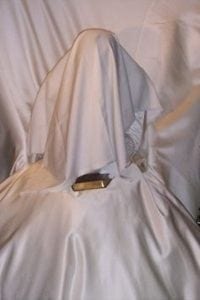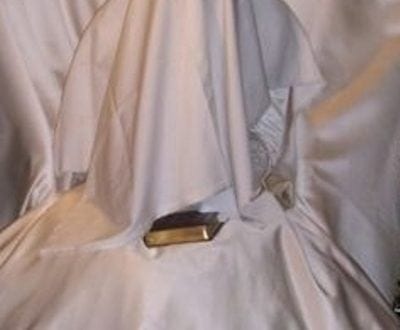Exploring the Hidden: Part 1
Our Ethnocentric Lens and the Role of Women in Judaism

I wrote this article over 25 years ago and it remains one of my favorite: The feminism I identified with as a teen and in college seemed at loggerheads with the spiritual path I was pursuing. It was this divide that I set out to explore. Why did Judaism at once feel so right and at the same time so wrong? It appeared to me then, and still does today, that the umbrage we take with our heritage is a result of an ethnocentric lens which renders Jewish values strange and even distasteful to our Western sensibilities. Identifying the two core differences freed me much resistance and enabled me to celebrate my birthright.
Within the framework of Jewish life, no aspect seems to be as fundamentally misunderstood as the role and status of women. This is possibly because the points of most significant divergence between Judaism and contemporary Western society occur precisely here, in the criteria of value by which a person’s status is determined. There are assumptions so deeply ingrained as to evade the attention of even those of us most wary of ethnocentric filters.
Perception of the Relative Value of the Public and Private Distort Framing of the Role of Women
The principal domain of the woman according to Torah is private. Furthermore, the feminine is related to the concept of the malchut, “sovereignty,” which is the last phase in the progressive manifestation of Divinity and is expressed in our physical world. Both privacy and the value of the physical are foreign concepts to the Western mind. It is these concepts which must be clarified before a true apprehension of the status of the Jewish woman can be reached.
According to Torah, the public domain is one of compromise. No matter how much integrity the person has, being in the public eye generates some degree of compromise, of assuming masks or roles, of molding one’s self to meet requirements however subtle. It is for this reason that the greatest leaders of the Jewish people invariably wished to avoid their appointment as leaders. Moses, our teacher, argued with G-d for three days in the desert before returning to Egypt to lead his beloved people out of slavery. Jonah fled from prophesying to the city of Ninveh and so too did Jeremiah seek to evade his calling. The Baal Shem Tov, founder of the Chassidic movement, lived his life as a Tzaddik nistar, one of the hidden righteous, until forced to reveal himself at the age of 36. He once said,
When I entered this world, I did so with another soul equal in greatness to my own. We made a pact, but I broke it once. Because of this, he was blessed with anonymity and I was condemned to fame.”
The story does not negate our knowledge that the Baal Shem Tov was destined for leadership and greatness even prior to birth. Rather, it serves to remind us of the teaching of our Rabbis, that “leadership is servitude,” and to moderate our esteem of public status in accordance with Torah precepts.
Why Privacy is a Yardstick of How Valued Something Is
The criteria of value according to Torah is privacy. In our ritual service, what which is most precious is concealed. The ark contains the Torah scrolls, each of which has its own elaborate covering. The Holy of Holies in the Temple was the most hidden of spaces. Only the High Priest could enter once a year on the Day of Atonement. The dress code of modesty required of Jews reflects this same principle. One can say that for Jews, not only is the private domain elevated above the public, but that which is hidden is so precisely because it has greatest value attributed to it.
The reason that the degree of concealment is a barometer, so to speak, of esteem, is because that which is hidden is both closer to the source of emanation, and more unified. Although G-d’s Oneness defies description, His manifestation in the material world is diversified. Whereas the name Hashem – the Tetragrammaton, which signifies that aspect of G-d which transcends creation – is singular, the name Elokim, which describes the G-d of nature, is plural. Hashem, G-d as He is beyond even the categories of finite and infinite, is higher than Elokim, plurality. Furthermore, albeit the source of light within the sun is not yet light, it is obviously higher than its emanated rays. Thus it is that concealment connotes preciousness. Something which can be seen is already removed from its source and part of the plurality of the world. That which is hidden is both closer to source and more intrinsically contained and unified.
In contrast to this aversion to the public eye are the billboards; pop stars; publicity columns and election campaigns which bear testimony to the value of fame in Western society. This value system is an ethnocentric filter which renders Judaism highly problematic and Jewish women second-class citizens to those observing through it. To someone educated to believe that that which is most prominent or visible is most valued, the hidden stance of women in a synagogue signifies a lowly status. The ritual bath which is fundamentally and predominantly connected with women, and the construction of which takes precedence over that of the synagogue, remains unseen by eyes focused on the immediately visible. To such an observer, the fact that a Jewish woman does not give evidence in court seals her degradation. Yet, for a community for whom any public domain is one of compromise, none is more so than a court of law. Just as a king cannot testify because a court of law is beneath his dignity, so too, do women abstain from participating in its machinations.
Purim and Shavuot
The value of the private is perhaps seen most clearly in the festival of Purim. The period of extreme danger and intense trials of the Jews of the Persian Empire is termed by G-d as a time when, haster astir panai, “I will surely hide my face.” The name of the heroine who awoke the Jews to repentance and entered the court of Achashverosh with self-sacrifice in order to save her people is Esther, whose name means “concealed.” The megillah we read each year bears Esther’s name and so too, the fast which precedes the festival. The leadership and action of Mordechai, Esther’s uncle, was a vital factor in the victory of Purim, yet neither the megillah nor the fast even share his name, and Esther remains the central heroine. Our rabbis teach that a name reflects an essential aspect of that which it signifies. The word Esther, then, and its prominence throughout the story of Purim guides us to a realization that the festival is concerned with concealment and the consequent emergence of preciousness.
Purim is compared by our sages to Shavuot, the Festival of the Giving of the Law. If Purim is associated with darkness and concealment, Shavuot is associated with light and revelation. Yet the comparison is made to point out the greatness of the former over the latter. The Midrash teaches that when G-d offered the Torah to the Jewish people, He did so with a mountain suspended over their heads. The implication is that even though the Jews responded in unison with unconditional acceptance to do and obey all of His laws, the choice was limited. It was not a real choosing, in that one cannot look Absolute Truth in the fact and reject it. Thus in some sense, the Jews did not fully take upon themselves the yoke of Torah at Mount Sinai. This acceptance occurred during the Persian exile when G-d’s “Face” was most concealed and yet the Jews affirmed their servitude to and love for G-d. Given the esteem which concealment indicates in Torah, it is not surprising that the most significant act of surrender our people could perform occurred through a hidden queen in the darkness of exile to a hidden G-d.
To take visibility as a criteria and impose it on Jewish life renders all that is most esteemed by Torah as lowly and worthless. The yardsticks are not the same.
Western Understandings of the Relationship Between Physical and Spiritual Distort Framing of the Role of Women
The second barrier to a true apprehension of worth in Judaism is the Western understanding of the relationship between the physical and the spiritual. This exists all the more so with regard to the value of women. Ultimately, according to Christianity, the physical is negative and must be renounced in order to attain holiness. In the Torah world view, the greatest heights and attachment to G-dliness can be achieved only through involvement with the physical. The commandments are obligations to be fulfilled through utilization of the material world: lighting Shabbat candles, placing a coin in a charity box, or wearing phylacteries (tefillin) are perceived as generating an essential union with G-d which a lifetime of contemplation cannot accomplish. Women have an essential connection with the power to elevate the potential of the physical world.
Rabbi Schneur Zalman, the author of the Tanya, goes so far as to state that while commandments are the garments of the soul, they are in fact even higher than the soul itself. These garments take the form of thought, speech and action. While most of our daily functioning involves actin, there are laws relating to purity of speech, and even more abstractly, emotion and thought in the obligations to love and fear and know G-d. Yet the focus on this world requires of us that even these commandments manifest physically.
One example of the supremacy of the physical is to be found in the construction of the mishkan, the temporary sanctuary the Jews built in the desert. The people of Israel had just witnessed the Giving of the Torah, the greatest and most open revelation of G-dliness. Yet the immediate consequence was not to meditate on their experience but to build the mishkan, a physical structure. Furthermore, it is that structure which becomes the house of the Shechina, the Divine presence. As G-d says to Moses, “Build me a sanctuary and I will dwell in it.”
One may well ask why this is the case. Why is the physical higher? Why, ultimately, will we witness the resurrection of the dead into physical bodies instead of making the transition to a purely spiritual existence? There is a principle in Torah that whatever descends lower has its roots in a higher source. This is true of all things. A person with an adequate understanding of a concept may be able to explain it to a contemporary but not to a child or someone with limited knowledge. A teacher who can bring a concept unchanged, but in different form, down to the level of a child is one who has a deeper grasp and internalization of what is being taught.
So too in the spiritual realm. Prophets invariably slept or underwent physical convulsions of some sort upon receiving prophecy. All except Moses. For our greatest of leaders and prophets, his apprehension of G-dliness was such that there no longer existed a contradiction between physical and spiritual and thus he received the word of G-d unaffected. His consciousness was higher and could therefore be brought lower. Similarly, with regard to miracles, despite their transcendent nature, they are in some way limited. The Baal Shem Tov employed numerous miraculous powers in his lifetime. His disciple’s disciple, Reb Schneur Zalman, tried to avoid performing miracles. At first glance, it may appear that the latter Rebbe was of a lower stature in that he did not perform miracles. Rather, he had no desire of doing so. A miracle implies breaking the laws of nature, accomplishing a goal only by going beyond the world. To accomplish the same thing but within the limitations of natural laws demands a strength even deeper in origin.
Thus it is in creation. For G-d to animate a spiritual being, an angel, requires a source less elevated than that required to animate a body. In the physical creation, G-d’s presence is no less present but infinitely less visible. To vivify a form where the source of life is entirely concealed requires that the source be definitely higher. Thus the root of the body is higher than that of the soul.
Continued in Part 2: Esther, Purim and a Fresh Take on the Role of Jewish Women




